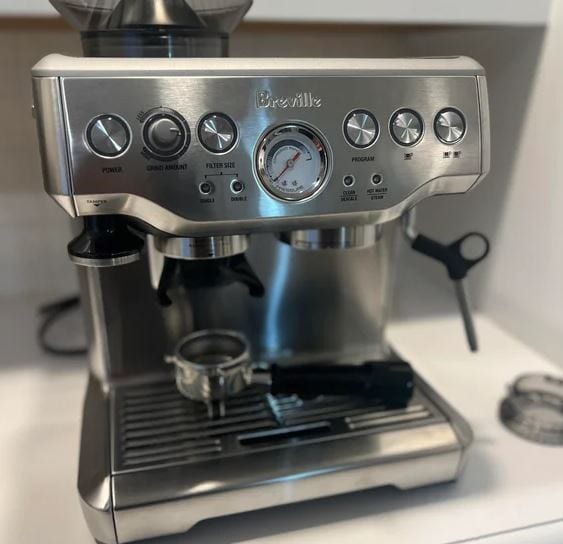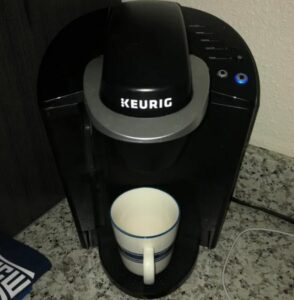Breville Espresso Machine Troubleshooting – Common Fixes
-
 By
Lucas Bennett
By
Lucas Bennett

There are several reasons why your Breville coffee machine may have stopped working. In this guide, we will be going over how to fix these issues step-by-step, covering problems like low pressure, steam wand blockages, and more.
Table of Contents
ToggleWater Reservoir alignment
Make sure the water reservoir of your Breville espresso machine is properly aligned and filled. A full and correctly positioned tank is crucial when it comes to its performance; even a slight misalignment can impact the entire brewing process. For the best results, use fresh, clean water. Avoid using distilled water as it lacks the essential minerals needed to build pressure, which is necessary for pulling the perfect espresso shot.
Keeping the Machine Clean
 Cleaning your Breville Barista Express espresso machine regularly is crucial for its longevity and performance. For one thing, it will help prevent buildup that could otherwise impair its functionality.
Cleaning your Breville Barista Express espresso machine regularly is crucial for its longevity and performance. For one thing, it will help prevent buildup that could otherwise impair its functionality.
To prevent the head gasket from becoming hard and brittle, we recommend cleaning it at least twice a year. When replacing a worn gasket, remember to remove all remnants of the old one for a proper seal.
Regular descaling is also important for preventing scale buildup, which can affect internal components like solenoids. While you can use vinegar, ACTIVE Coffee Machine Descaler is a much better option as it’s specifically formulated to keep your machine running smoothly, preserving the flavor and aroma of your coffee and extending the machine’s life.
Portafilter and Basket Inspection
Leftover oils and coffee residue inside the portafilter and basket can affect the taste of your espresso and the machine’s performance. To clean it, soak the metal parts of the portafilter in hot soapy water. We also recommend flushing the portafilter after each use.
Grind Size for Optimal Pressure
The correct grind size plays an important role in ensuring optimal pressure when you’re pulling a rich, flavorful shot. Typically, a fine-medium grind size works best for Breville machines.
As a general rule, you want to use 18-20 grams of coffee for a double shot. A grind that’s too fine can clog the basket, resulting in low pressure so be sure to monitor the pressure gauge during extraction to ensure it reaches the optimal pressure zone.
Checking for Steam Wand Blockages

The steam wand is crucial for frothing milk and creating lattes and cappuccinos, but it can become clogged if it’s not maintained properly.
To prevent blockages, make sure to clean the steam wand regularly. It’s also a good idea to run water through the machine without the portafilter to check for anyh internal blockages. If the water flow slows, it may be time to descale the machine.
Inspecting the Pump and Pressure Gauge
The key to identifying issues early is to pay attention to any changes in sound. For example, a weaker-than-usual sound from the pump may indicate an underlying issue. The pressure gauge should also read within the optimal range for proper espresso extraction. If it fails to show movement, there may be a blockage.
Maintaining the Group Head Gasket
The group head gasket ensures a tight seal during brewing. With regular use, however, it can wear out so be sure to check it regularly for any signs of wear and tear.
If you notice any leaks or damage, it may be time to replace the entire part.
Diagnosing Solenoid Valve Issues
A healthy solenoid valve should have a resistance measurement of 2200-2400 ohms.
If it becomes damaged, it can significantly impact the performance of your machine. Signs of potential problems include a lack of pressure and pausing during brewing.
When Professional Help is Needed
 Despite your best efforts, professional help may be needed in some cases. For example, you may need to contact Breville’s customer service team if you are experiencing persistent low pressure or malfunctioning pumps. Seeking professional assistance will not only save you time but will also prevent further damage.
Despite your best efforts, professional help may be needed in some cases. For example, you may need to contact Breville’s customer service team if you are experiencing persistent low pressure or malfunctioning pumps. Seeking professional assistance will not only save you time but will also prevent further damage.
Summary
Maintaining your Breville espresso machine involves several steps, from making sure the water tank is aligned properly to diagnosing solenoid valve issues. Regular cleaning and descaling will also prevent common issues and extend the life of your machine.
Key Takeaways
- Make sure the water reservoir is filled with fresh water and aligned properly before brewing
- In addition to regular cleaning and descaling, it’s also important to inspect components such as the portafilter and group gasket regularly for damage
- To identify issues early, monitor the pressure gauge and listen for any unusual pump sounds; don’t hesitate to seek professional help if problems persist.
How to Fix Breville Espresso Machine – Frequently Asked Questions
How often should I descale Breville espresso machines?
You should descale your Breville espresso machine once every 2-3 months to keep it running smoothly.
What type of water should I use in my Breville espresso machine?
For the best results, use fresh, clean water in your Breville espresso machine. Avoid using distilled water as it doesn’t have the necessary minerals for optimal brewing.
How can I tell if my portafilter needs cleaning?
Generally speaking, you should clean the portafilter if there are visible oil or coffee residues.
What should I do if my steam wand is blocked?
If your steam wand is blocked, run water through the machine without the portafilter; that will help clear the blockage. If that doesn’t work, consider descaling your machine with ACTIVE Coffee Machine Descaler Liquid.
When should I seek professional help for my espresso machine?
If you run into persistent issues (e.g. constant low pressure) with your espresso machine, it may be time to call in a professional.
15% Off Amazon Coupon
×Click To Reveal The 15% Off Coupon Code For Your Entire ACTIVE Purchase At Amazon.com
Note: This promotional offer is only guaranteed through the end of the day.




